Evaluating Standard and Target Costing in Managerial Accounting
VerifiedAdded on 2022/08/20
|16
|3993
|14
Report
AI Summary
This report delves into the significance of standard and target costing systems within the realm of managerial accounting. It aims to evaluate their importance in managerial decision-making, supported by an analysis of relevant journal articles. The report explores standard costing as a planning and control system, examining its application in the British iron and steel industry. It also investigates target costing, highlighting its role in cost management, particularly within the construction industry. The study contrasts standard and target costing techniques, emphasizing their similarities and differences. The report concludes that contemporary organizations should integrate both standard and target costing methods for effective management accounting, enabling efficient decision-making processes. It also reviews the merits and demerits of both costing systems, providing recommendations for their effective implementation and use.
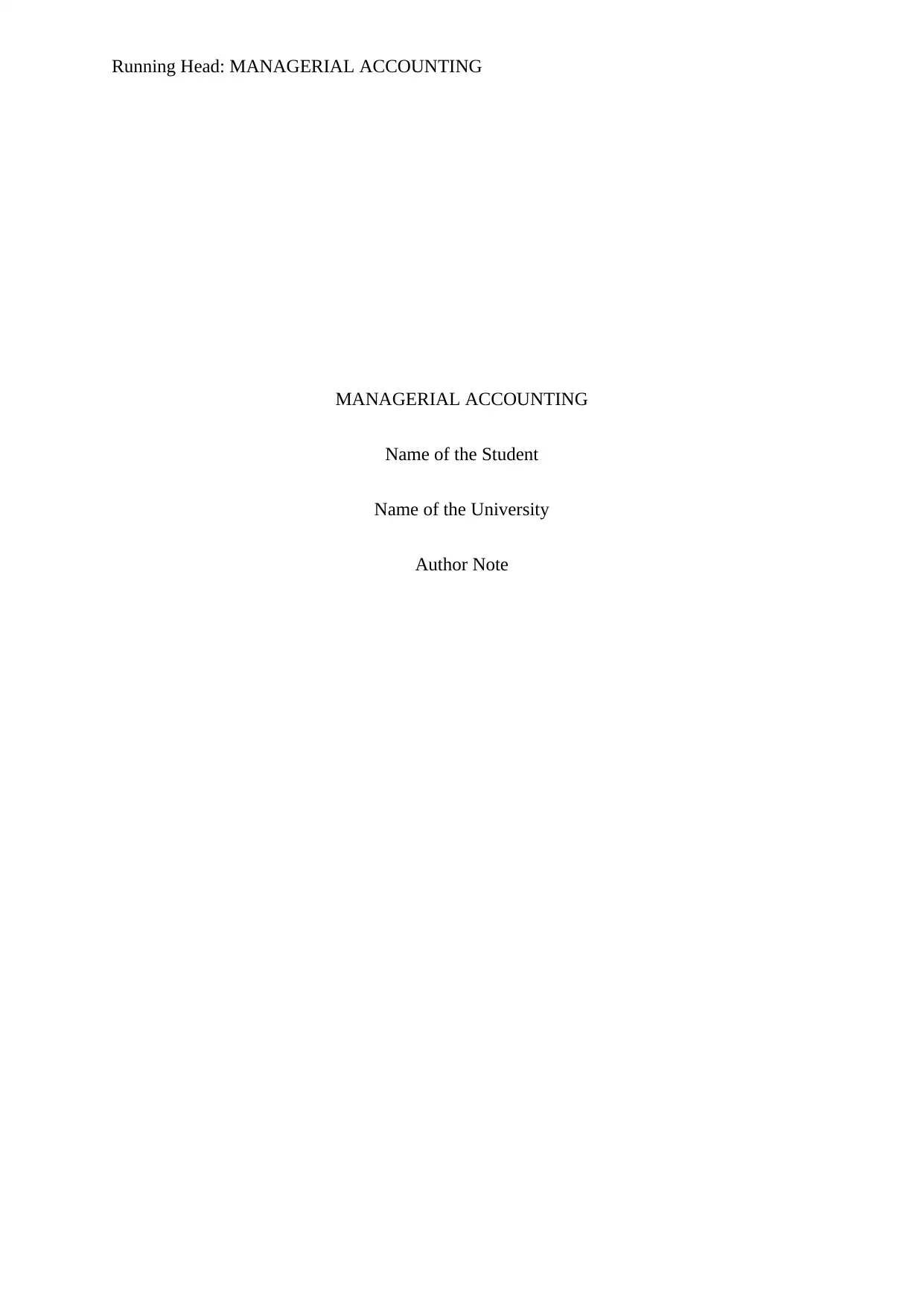
Running Head: MANAGERIAL ACCOUNTING
MANAGERIAL ACCOUNTING
Name of the Student
Name of the University
Author Note
MANAGERIAL ACCOUNTING
Name of the Student
Name of the University
Author Note
Paraphrase This Document
Need a fresh take? Get an instant paraphrase of this document with our AI Paraphraser
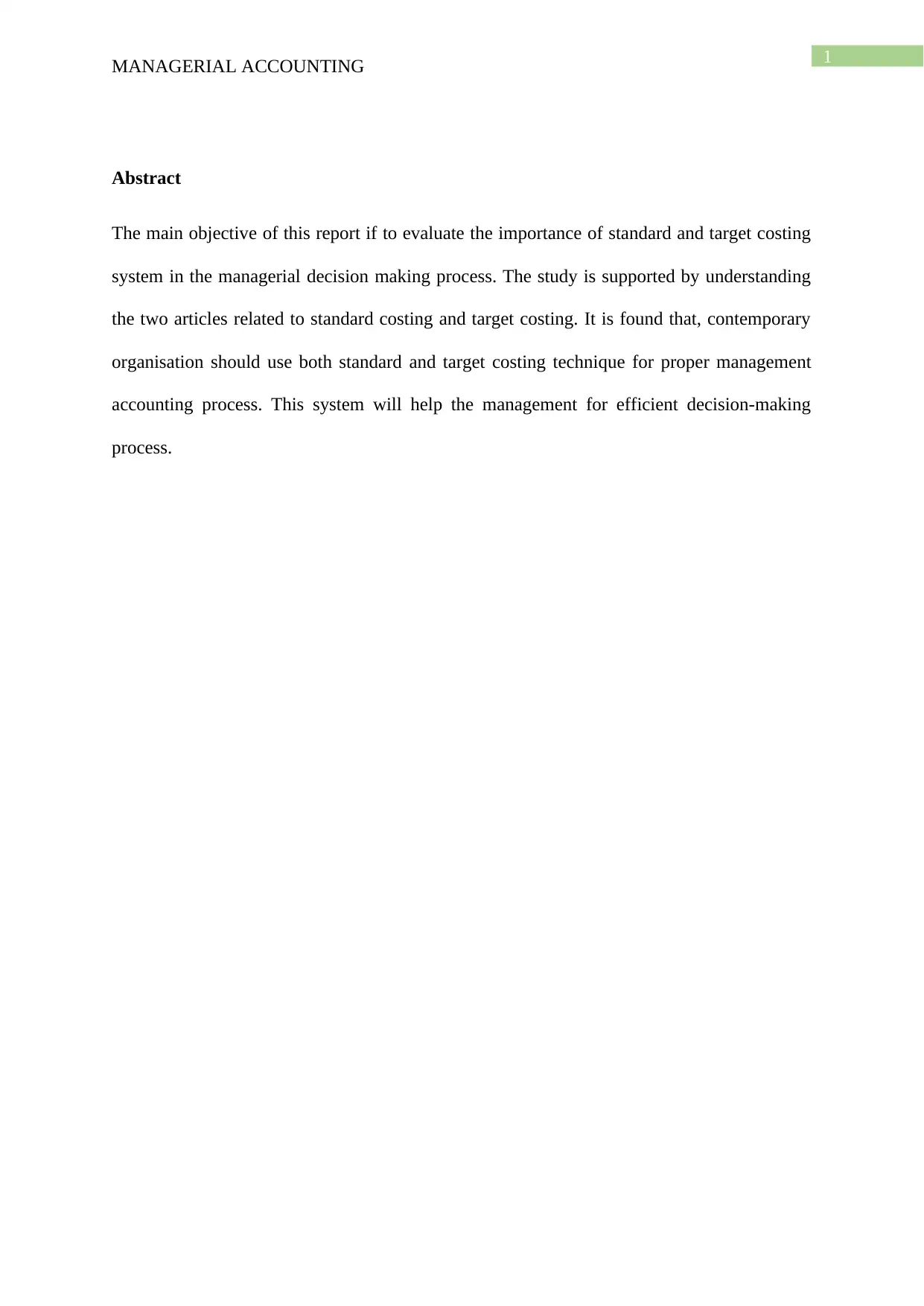
1
MANAGERIAL ACCOUNTING
Abstract
The main objective of this report if to evaluate the importance of standard and target costing
system in the managerial decision making process. The study is supported by understanding
the two articles related to standard costing and target costing. It is found that, contemporary
organisation should use both standard and target costing technique for proper management
accounting process. This system will help the management for efficient decision-making
process.
MANAGERIAL ACCOUNTING
Abstract
The main objective of this report if to evaluate the importance of standard and target costing
system in the managerial decision making process. The study is supported by understanding
the two articles related to standard costing and target costing. It is found that, contemporary
organisation should use both standard and target costing technique for proper management
accounting process. This system will help the management for efficient decision-making
process.
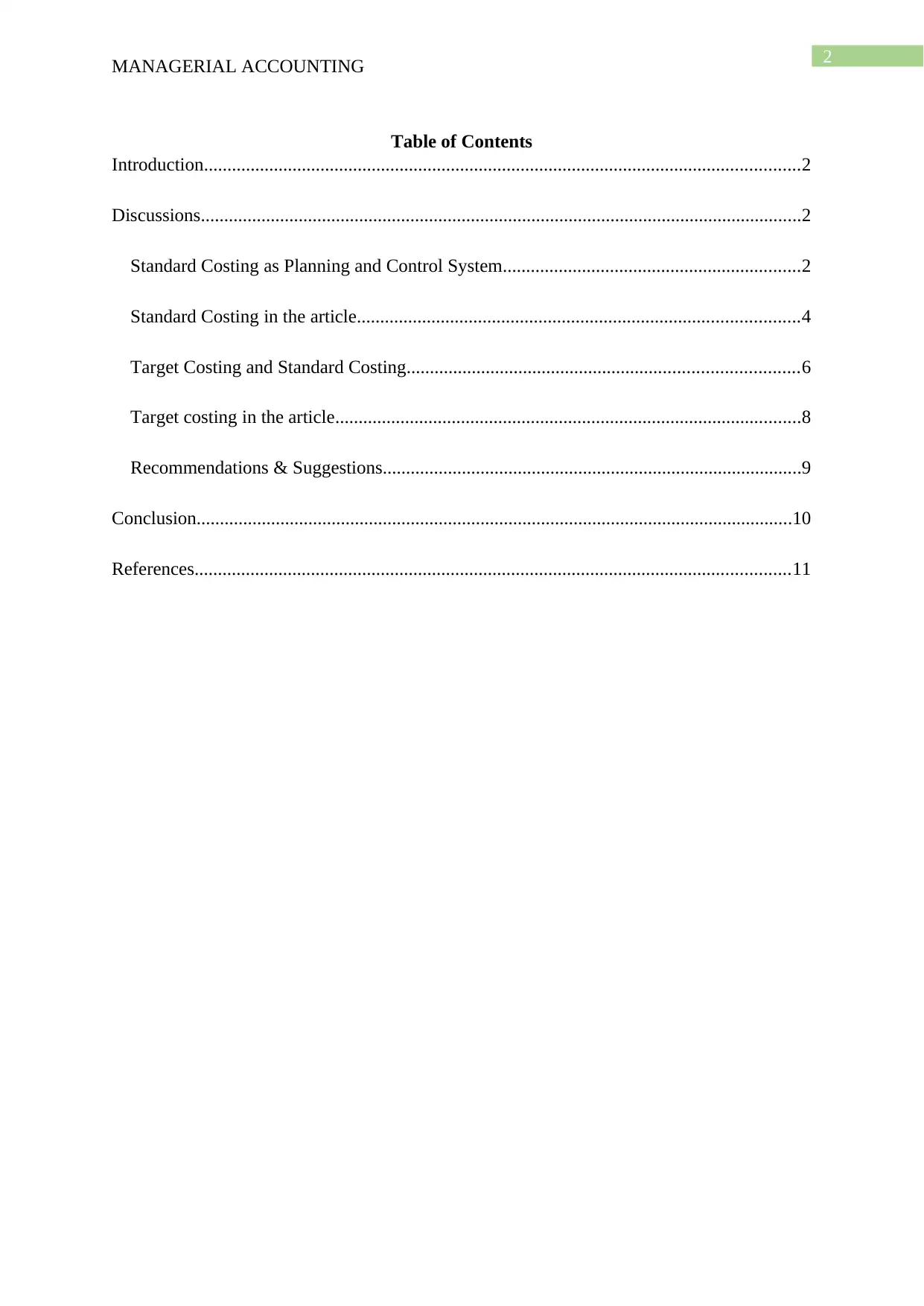
2
MANAGERIAL ACCOUNTING
Table of Contents
Introduction................................................................................................................................2
Discussions.................................................................................................................................2
Standard Costing as Planning and Control System................................................................2
Standard Costing in the article...............................................................................................4
Target Costing and Standard Costing....................................................................................6
Target costing in the article....................................................................................................8
Recommendations & Suggestions..........................................................................................9
Conclusion................................................................................................................................10
References................................................................................................................................11
MANAGERIAL ACCOUNTING
Table of Contents
Introduction................................................................................................................................2
Discussions.................................................................................................................................2
Standard Costing as Planning and Control System................................................................2
Standard Costing in the article...............................................................................................4
Target Costing and Standard Costing....................................................................................6
Target costing in the article....................................................................................................8
Recommendations & Suggestions..........................................................................................9
Conclusion................................................................................................................................10
References................................................................................................................................11
⊘ This is a preview!⊘
Do you want full access?
Subscribe today to unlock all pages.

Trusted by 1+ million students worldwide

3
MANAGERIAL ACCOUNTING
Introduction
Managerial accounting system is a very important aspect of any business. The
management should look after a strategic decisions on implementing an appropriate decision-
making process. This paper will focus on the importance of two type of cost management
techniques that is used by the management; target costing and standard costing. The
importance of both the costing techniques are discussed in this report. This concept is related
to the journal article on standard and target costing. The article of standard costing will focus
on the costing system of steel and iron industry and the article of target costing will focus on
the costing system of Construction Company. The objective of this report is to understand the
importance of standard and target costing system in the managerial decision making process.
Discussions
Standard Costing as Planning and Control System
Standard costing system is a practice of managerial accounting system that is used as
a costing techniques. This technique is used to compare the actual cost and the expected cost
of the product or services. The main objectives of standard costing system are:
To implement the budget in the business operations.
To predetermine the performance of the business.
To properly utilise the raw materials, labour and the overheads of the business.
To motivate the employees and the management to improve their performance.
To supply an efficient data related to the cost in order to fix the selling price of the
firm.
To help the manager for efficient decision process related to price, buying decisions
and other decisions (Cooper 2017).
Features of standard costing system:
MANAGERIAL ACCOUNTING
Introduction
Managerial accounting system is a very important aspect of any business. The
management should look after a strategic decisions on implementing an appropriate decision-
making process. This paper will focus on the importance of two type of cost management
techniques that is used by the management; target costing and standard costing. The
importance of both the costing techniques are discussed in this report. This concept is related
to the journal article on standard and target costing. The article of standard costing will focus
on the costing system of steel and iron industry and the article of target costing will focus on
the costing system of Construction Company. The objective of this report is to understand the
importance of standard and target costing system in the managerial decision making process.
Discussions
Standard Costing as Planning and Control System
Standard costing system is a practice of managerial accounting system that is used as
a costing techniques. This technique is used to compare the actual cost and the expected cost
of the product or services. The main objectives of standard costing system are:
To implement the budget in the business operations.
To predetermine the performance of the business.
To properly utilise the raw materials, labour and the overheads of the business.
To motivate the employees and the management to improve their performance.
To supply an efficient data related to the cost in order to fix the selling price of the
firm.
To help the manager for efficient decision process related to price, buying decisions
and other decisions (Cooper 2017).
Features of standard costing system:
Paraphrase This Document
Need a fresh take? Get an instant paraphrase of this document with our AI Paraphraser

4
MANAGERIAL ACCOUNTING
Standard costing helps in determining the cost of the output. Standard costing system is
designed to estimate and predict the cost of the operations according to the past
experiences of the operations. It compares the actual cost of the products with the
expected costs. The variance between the actual and expected costs are used to predict the
result. Variance is a performance indicator that is used to check the future trend of
associated with the cost. This system is helpful for the top management for preparing and
reporting the company’s annual report. The management can identify the reason for the
variance. This system gives a correct suggestions to the management for the change in the
variance activity. Standard costing system is used for identifying and estimating the
current condition of the business. It identifies the actual cost of the current trend by
examining the historical book of accounts of the related costs.
The application of Standard Costing system has many advantages in the organisation. The
following are the advantages of standard costing:
It guides the management of a company in formulating the buying related decisions
and policies in an organisation.
Standard costing system helps in cost reduction in the business.
Standard costing system will analyse the variance between the actual cost and the
expected cost of the products or services.
It helps in predetermining the costs that can help the management in budgeting and
estimating the cost of the business operations (Tsai, Lan & Huang 2019).
Standard cost is fixed for the product or service. Therefore, it reduces the cost and
improve the efficiency of the business and ultimately increase the profit.
Standard costing system helps to improve the responsibility and authority of the
employees by setting a standard cost and accordingly taking corrective measures to
control the costs.
MANAGERIAL ACCOUNTING
Standard costing helps in determining the cost of the output. Standard costing system is
designed to estimate and predict the cost of the operations according to the past
experiences of the operations. It compares the actual cost of the products with the
expected costs. The variance between the actual and expected costs are used to predict the
result. Variance is a performance indicator that is used to check the future trend of
associated with the cost. This system is helpful for the top management for preparing and
reporting the company’s annual report. The management can identify the reason for the
variance. This system gives a correct suggestions to the management for the change in the
variance activity. Standard costing system is used for identifying and estimating the
current condition of the business. It identifies the actual cost of the current trend by
examining the historical book of accounts of the related costs.
The application of Standard Costing system has many advantages in the organisation. The
following are the advantages of standard costing:
It guides the management of a company in formulating the buying related decisions
and policies in an organisation.
Standard costing system helps in cost reduction in the business.
Standard costing system will analyse the variance between the actual cost and the
expected cost of the products or services.
It helps in predetermining the costs that can help the management in budgeting and
estimating the cost of the business operations (Tsai, Lan & Huang 2019).
Standard cost is fixed for the product or service. Therefore, it reduces the cost and
improve the efficiency of the business and ultimately increase the profit.
Standard costing system helps to improve the responsibility and authority of the
employees by setting a standard cost and accordingly taking corrective measures to
control the costs.
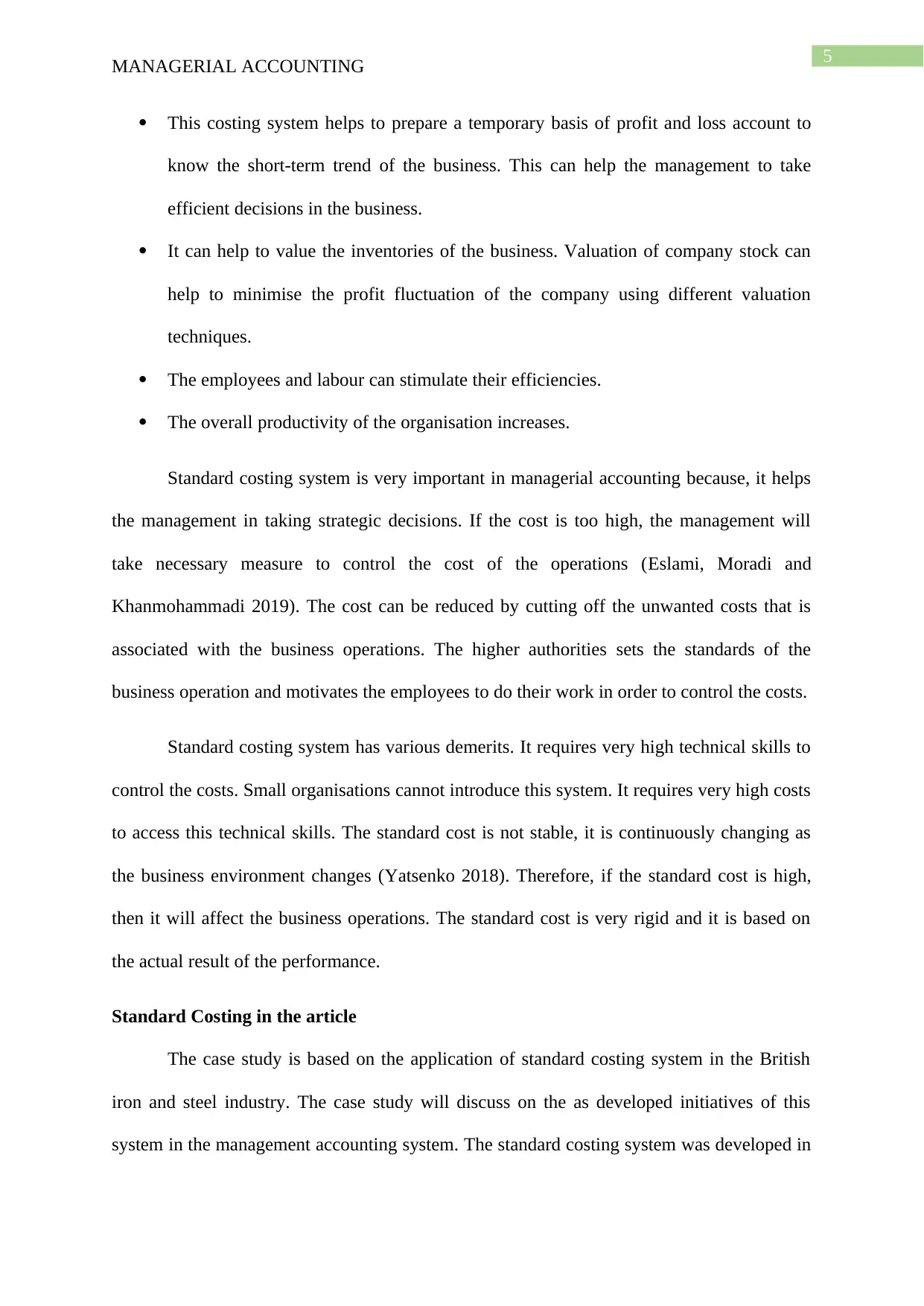
5
MANAGERIAL ACCOUNTING
This costing system helps to prepare a temporary basis of profit and loss account to
know the short-term trend of the business. This can help the management to take
efficient decisions in the business.
It can help to value the inventories of the business. Valuation of company stock can
help to minimise the profit fluctuation of the company using different valuation
techniques.
The employees and labour can stimulate their efficiencies.
The overall productivity of the organisation increases.
Standard costing system is very important in managerial accounting because, it helps
the management in taking strategic decisions. If the cost is too high, the management will
take necessary measure to control the cost of the operations (Eslami, Moradi and
Khanmohammadi 2019). The cost can be reduced by cutting off the unwanted costs that is
associated with the business operations. The higher authorities sets the standards of the
business operation and motivates the employees to do their work in order to control the costs.
Standard costing system has various demerits. It requires very high technical skills to
control the costs. Small organisations cannot introduce this system. It requires very high costs
to access this technical skills. The standard cost is not stable, it is continuously changing as
the business environment changes (Yatsenko 2018). Therefore, if the standard cost is high,
then it will affect the business operations. The standard cost is very rigid and it is based on
the actual result of the performance.
Standard Costing in the article
The case study is based on the application of standard costing system in the British
iron and steel industry. The case study will discuss on the as developed initiatives of this
system in the management accounting system. The standard costing system was developed in
MANAGERIAL ACCOUNTING
This costing system helps to prepare a temporary basis of profit and loss account to
know the short-term trend of the business. This can help the management to take
efficient decisions in the business.
It can help to value the inventories of the business. Valuation of company stock can
help to minimise the profit fluctuation of the company using different valuation
techniques.
The employees and labour can stimulate their efficiencies.
The overall productivity of the organisation increases.
Standard costing system is very important in managerial accounting because, it helps
the management in taking strategic decisions. If the cost is too high, the management will
take necessary measure to control the cost of the operations (Eslami, Moradi and
Khanmohammadi 2019). The cost can be reduced by cutting off the unwanted costs that is
associated with the business operations. The higher authorities sets the standards of the
business operation and motivates the employees to do their work in order to control the costs.
Standard costing system has various demerits. It requires very high technical skills to
control the costs. Small organisations cannot introduce this system. It requires very high costs
to access this technical skills. The standard cost is not stable, it is continuously changing as
the business environment changes (Yatsenko 2018). Therefore, if the standard cost is high,
then it will affect the business operations. The standard cost is very rigid and it is based on
the actual result of the performance.
Standard Costing in the article
The case study is based on the application of standard costing system in the British
iron and steel industry. The case study will discuss on the as developed initiatives of this
system in the management accounting system. The standard costing system was developed in
⊘ This is a preview!⊘
Do you want full access?
Subscribe today to unlock all pages.

Trusted by 1+ million students worldwide

6
MANAGERIAL ACCOUNTING
order to take responsibility in the accounting system. This system was first adopted by a
British iron & steel company. This case study has developed a clear understanding on the
different stages of development of cost management technique (Edwards, Boyns & Matthews
2002). The iron and steel industry has done early innovations by introducing the double entry
book-keeping system. Book-keeping system was used to formulate the price and profit of the
respective department. This industry revealed that, performance indicators can be used to
compare the price with the help of physical yield. After the regression period of iron and steel
industry, the ministry of supply took accountabilities to control their profits and unethical
activities like price fixing. The overall profits were compared with the rate of return of the
business capital. This industry were achieved to control their cost of business operations. This
industry was supervised and encouraged for modern innovations of steel industry. The
industry was re-established in the economy. But, after continuing this technique with the
business operations various changes raised in the business system such as experimenting
different method of price fixing, use of cost sheets like ledger and other numerical analysis
methods. It affected the earnings of the business. According to ISB, the main reason of
industry failure is due to more equipment in larger size. The profits of the iron and steel
industry had unfavourably affected the pricing policy employed by ISB. The producers were
unable to raise profit during this period. The earnings was comparatively very lower.
Standard costing system have allowed the employers to collect their incentives. There were
multiple changes happened in the British industry. Standard costing system had bought
advantageous changes in the accounting process of the business. It helps to measure a
predetermine figure of the estimated cost. This system helps in preparing a budget that can
help to compare the figures of accounting system. The variance raised from the
manufacturing operations were reported to the management. The variance were achieved
from the comparison of predetermined standards with the actual performance. The interim
MANAGERIAL ACCOUNTING
order to take responsibility in the accounting system. This system was first adopted by a
British iron & steel company. This case study has developed a clear understanding on the
different stages of development of cost management technique (Edwards, Boyns & Matthews
2002). The iron and steel industry has done early innovations by introducing the double entry
book-keeping system. Book-keeping system was used to formulate the price and profit of the
respective department. This industry revealed that, performance indicators can be used to
compare the price with the help of physical yield. After the regression period of iron and steel
industry, the ministry of supply took accountabilities to control their profits and unethical
activities like price fixing. The overall profits were compared with the rate of return of the
business capital. This industry were achieved to control their cost of business operations. This
industry was supervised and encouraged for modern innovations of steel industry. The
industry was re-established in the economy. But, after continuing this technique with the
business operations various changes raised in the business system such as experimenting
different method of price fixing, use of cost sheets like ledger and other numerical analysis
methods. It affected the earnings of the business. According to ISB, the main reason of
industry failure is due to more equipment in larger size. The profits of the iron and steel
industry had unfavourably affected the pricing policy employed by ISB. The producers were
unable to raise profit during this period. The earnings was comparatively very lower.
Standard costing system have allowed the employers to collect their incentives. There were
multiple changes happened in the British industry. Standard costing system had bought
advantageous changes in the accounting process of the business. It helps to measure a
predetermine figure of the estimated cost. This system helps in preparing a budget that can
help to compare the figures of accounting system. The variance raised from the
manufacturing operations were reported to the management. The variance were achieved
from the comparison of predetermined standards with the actual performance. The interim
Paraphrase This Document
Need a fresh take? Get an instant paraphrase of this document with our AI Paraphraser
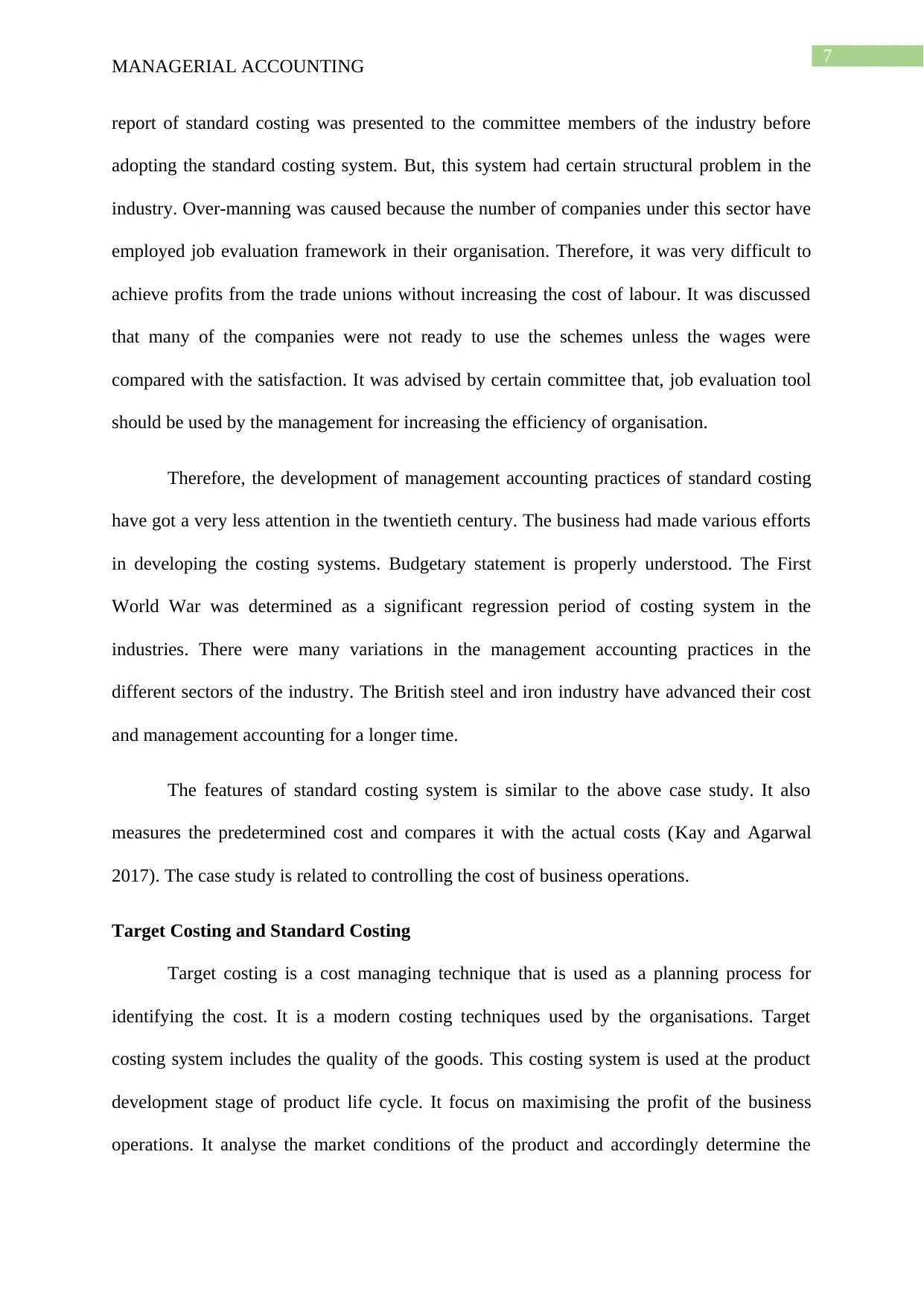
7
MANAGERIAL ACCOUNTING
report of standard costing was presented to the committee members of the industry before
adopting the standard costing system. But, this system had certain structural problem in the
industry. Over-manning was caused because the number of companies under this sector have
employed job evaluation framework in their organisation. Therefore, it was very difficult to
achieve profits from the trade unions without increasing the cost of labour. It was discussed
that many of the companies were not ready to use the schemes unless the wages were
compared with the satisfaction. It was advised by certain committee that, job evaluation tool
should be used by the management for increasing the efficiency of organisation.
Therefore, the development of management accounting practices of standard costing
have got a very less attention in the twentieth century. The business had made various efforts
in developing the costing systems. Budgetary statement is properly understood. The First
World War was determined as a significant regression period of costing system in the
industries. There were many variations in the management accounting practices in the
different sectors of the industry. The British steel and iron industry have advanced their cost
and management accounting for a longer time.
The features of standard costing system is similar to the above case study. It also
measures the predetermined cost and compares it with the actual costs (Kay and Agarwal
2017). The case study is related to controlling the cost of business operations.
Target Costing and Standard Costing
Target costing is a cost managing technique that is used as a planning process for
identifying the cost. It is a modern costing techniques used by the organisations. Target
costing system includes the quality of the goods. This costing system is used at the product
development stage of product life cycle. It focus on maximising the profit of the business
operations. It analyse the market conditions of the product and accordingly determine the
MANAGERIAL ACCOUNTING
report of standard costing was presented to the committee members of the industry before
adopting the standard costing system. But, this system had certain structural problem in the
industry. Over-manning was caused because the number of companies under this sector have
employed job evaluation framework in their organisation. Therefore, it was very difficult to
achieve profits from the trade unions without increasing the cost of labour. It was discussed
that many of the companies were not ready to use the schemes unless the wages were
compared with the satisfaction. It was advised by certain committee that, job evaluation tool
should be used by the management for increasing the efficiency of organisation.
Therefore, the development of management accounting practices of standard costing
have got a very less attention in the twentieth century. The business had made various efforts
in developing the costing systems. Budgetary statement is properly understood. The First
World War was determined as a significant regression period of costing system in the
industries. There were many variations in the management accounting practices in the
different sectors of the industry. The British steel and iron industry have advanced their cost
and management accounting for a longer time.
The features of standard costing system is similar to the above case study. It also
measures the predetermined cost and compares it with the actual costs (Kay and Agarwal
2017). The case study is related to controlling the cost of business operations.
Target Costing and Standard Costing
Target costing is a cost managing technique that is used as a planning process for
identifying the cost. It is a modern costing techniques used by the organisations. Target
costing system includes the quality of the goods. This costing system is used at the product
development stage of product life cycle. It focus on maximising the profit of the business
operations. It analyse the market conditions of the product and accordingly determine the
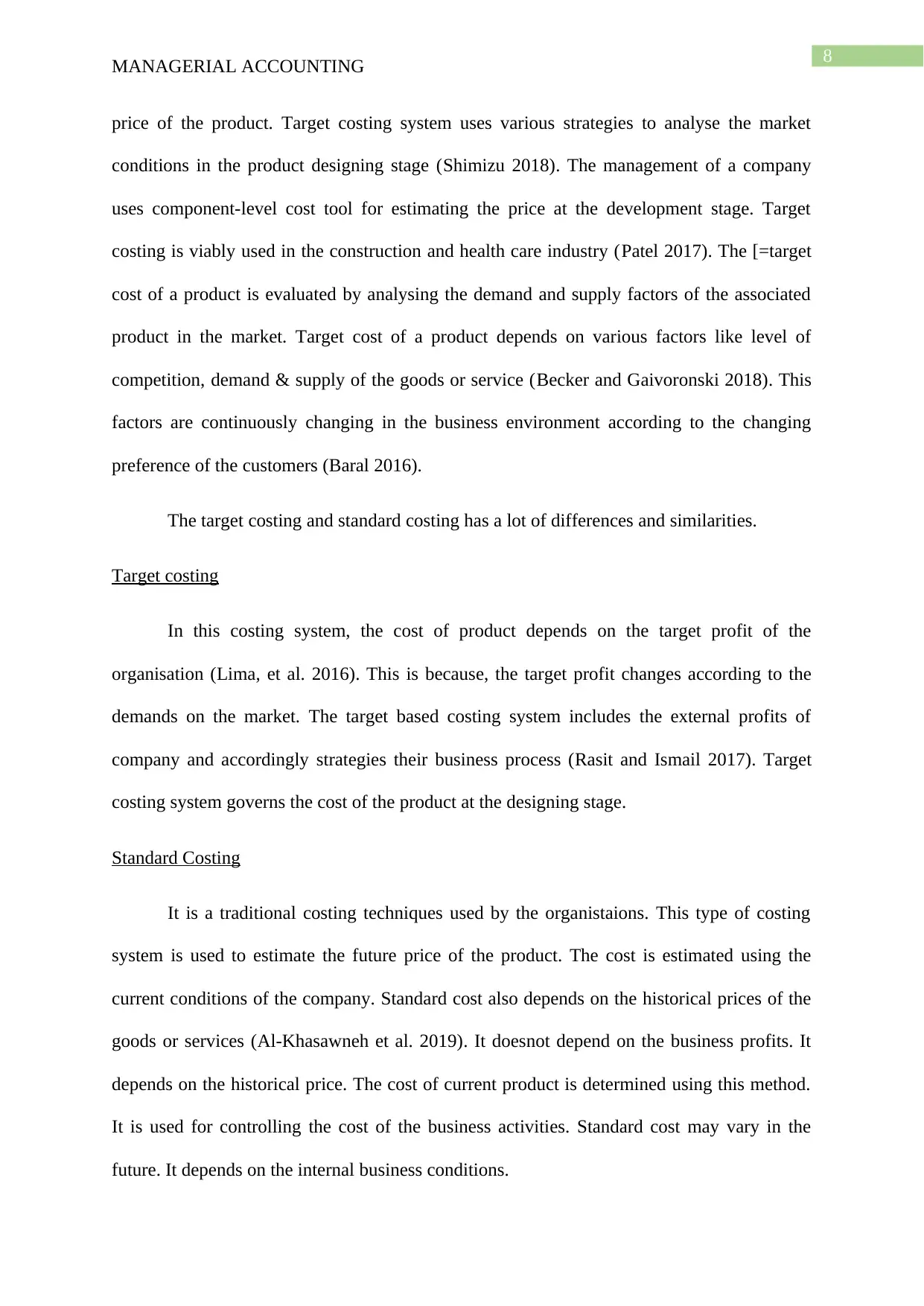
8
MANAGERIAL ACCOUNTING
price of the product. Target costing system uses various strategies to analyse the market
conditions in the product designing stage (Shimizu 2018). The management of a company
uses component-level cost tool for estimating the price at the development stage. Target
costing is viably used in the construction and health care industry (Patel 2017). The [=target
cost of a product is evaluated by analysing the demand and supply factors of the associated
product in the market. Target cost of a product depends on various factors like level of
competition, demand & supply of the goods or service (Becker and Gaivoronski 2018). This
factors are continuously changing in the business environment according to the changing
preference of the customers (Baral 2016).
The target costing and standard costing has a lot of differences and similarities.
Target costing
In this costing system, the cost of product depends on the target profit of the
organisation (Lima, et al. 2016). This is because, the target profit changes according to the
demands on the market. The target based costing system includes the external profits of
company and accordingly strategies their business process (Rasit and Ismail 2017). Target
costing system governs the cost of the product at the designing stage.
Standard Costing
It is a traditional costing techniques used by the organistaions. This type of costing
system is used to estimate the future price of the product. The cost is estimated using the
current conditions of the company. Standard cost also depends on the historical prices of the
goods or services (Al-Khasawneh et al. 2019). It doesnot depend on the business profits. It
depends on the historical price. The cost of current product is determined using this method.
It is used for controlling the cost of the business activities. Standard cost may vary in the
future. It depends on the internal business conditions.
MANAGERIAL ACCOUNTING
price of the product. Target costing system uses various strategies to analyse the market
conditions in the product designing stage (Shimizu 2018). The management of a company
uses component-level cost tool for estimating the price at the development stage. Target
costing is viably used in the construction and health care industry (Patel 2017). The [=target
cost of a product is evaluated by analysing the demand and supply factors of the associated
product in the market. Target cost of a product depends on various factors like level of
competition, demand & supply of the goods or service (Becker and Gaivoronski 2018). This
factors are continuously changing in the business environment according to the changing
preference of the customers (Baral 2016).
The target costing and standard costing has a lot of differences and similarities.
Target costing
In this costing system, the cost of product depends on the target profit of the
organisation (Lima, et al. 2016). This is because, the target profit changes according to the
demands on the market. The target based costing system includes the external profits of
company and accordingly strategies their business process (Rasit and Ismail 2017). Target
costing system governs the cost of the product at the designing stage.
Standard Costing
It is a traditional costing techniques used by the organistaions. This type of costing
system is used to estimate the future price of the product. The cost is estimated using the
current conditions of the company. Standard cost also depends on the historical prices of the
goods or services (Al-Khasawneh et al. 2019). It doesnot depend on the business profits. It
depends on the historical price. The cost of current product is determined using this method.
It is used for controlling the cost of the business activities. Standard cost may vary in the
future. It depends on the internal business conditions.
⊘ This is a preview!⊘
Do you want full access?
Subscribe today to unlock all pages.

Trusted by 1+ million students worldwide
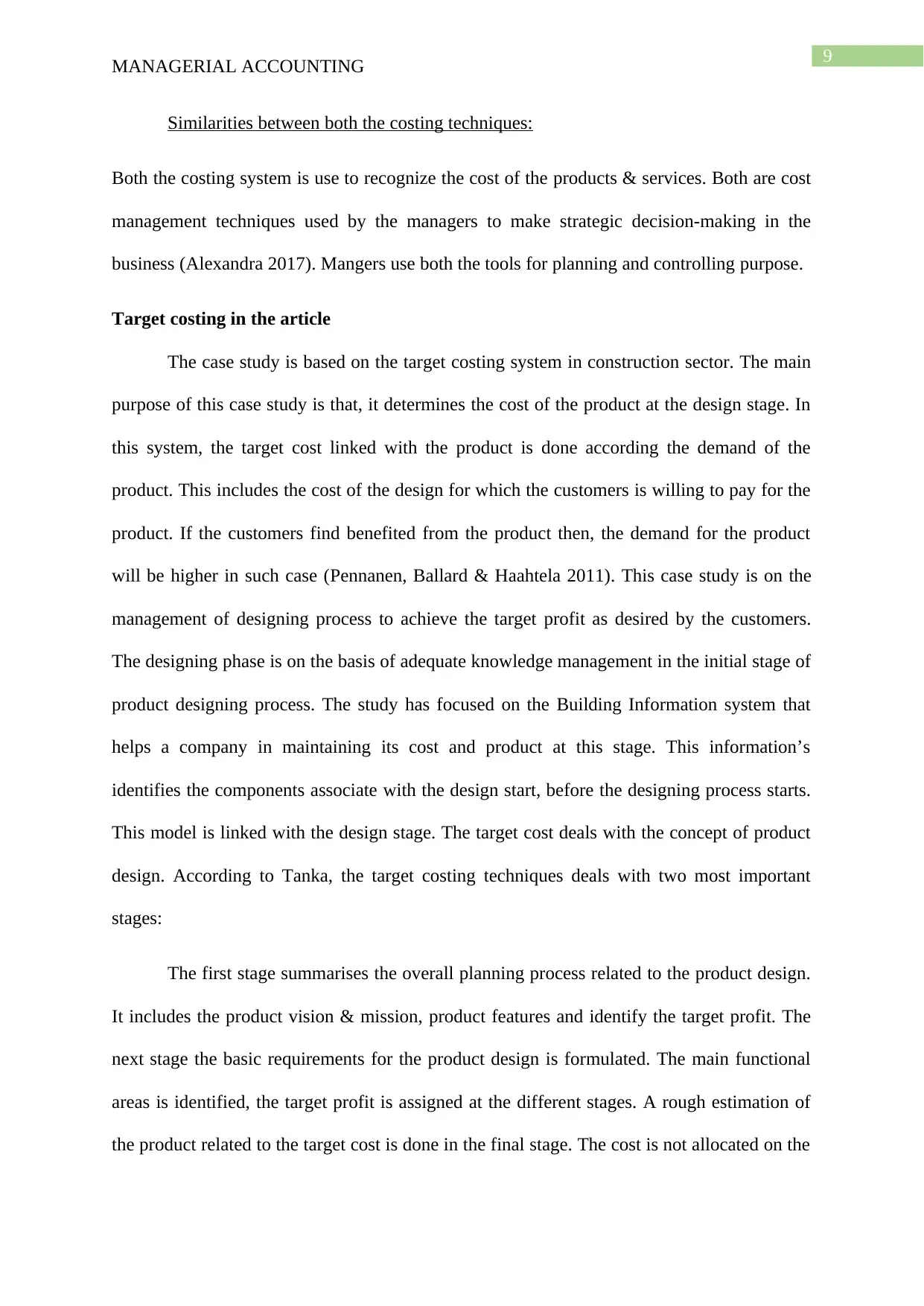
9
MANAGERIAL ACCOUNTING
Similarities between both the costing techniques:
Both the costing system is use to recognize the cost of the products & services. Both are cost
management techniques used by the managers to make strategic decision-making in the
business (Alexandra 2017). Mangers use both the tools for planning and controlling purpose.
Target costing in the article
The case study is based on the target costing system in construction sector. The main
purpose of this case study is that, it determines the cost of the product at the design stage. In
this system, the target cost linked with the product is done according the demand of the
product. This includes the cost of the design for which the customers is willing to pay for the
product. If the customers find benefited from the product then, the demand for the product
will be higher in such case (Pennanen, Ballard & Haahtela 2011). This case study is on the
management of designing process to achieve the target profit as desired by the customers.
The designing phase is on the basis of adequate knowledge management in the initial stage of
product designing process. The study has focused on the Building Information system that
helps a company in maintaining its cost and product at this stage. This information’s
identifies the components associate with the design start, before the designing process starts.
This model is linked with the design stage. The target cost deals with the concept of product
design. According to Tanka, the target costing techniques deals with two most important
stages:
The first stage summarises the overall planning process related to the product design.
It includes the product vision & mission, product features and identify the target profit. The
next stage the basic requirements for the product design is formulated. The main functional
areas is identified, the target profit is assigned at the different stages. A rough estimation of
the product related to the target cost is done in the final stage. The cost is not allocated on the
MANAGERIAL ACCOUNTING
Similarities between both the costing techniques:
Both the costing system is use to recognize the cost of the products & services. Both are cost
management techniques used by the managers to make strategic decision-making in the
business (Alexandra 2017). Mangers use both the tools for planning and controlling purpose.
Target costing in the article
The case study is based on the target costing system in construction sector. The main
purpose of this case study is that, it determines the cost of the product at the design stage. In
this system, the target cost linked with the product is done according the demand of the
product. This includes the cost of the design for which the customers is willing to pay for the
product. If the customers find benefited from the product then, the demand for the product
will be higher in such case (Pennanen, Ballard & Haahtela 2011). This case study is on the
management of designing process to achieve the target profit as desired by the customers.
The designing phase is on the basis of adequate knowledge management in the initial stage of
product designing process. The study has focused on the Building Information system that
helps a company in maintaining its cost and product at this stage. This information’s
identifies the components associate with the design start, before the designing process starts.
This model is linked with the design stage. The target cost deals with the concept of product
design. According to Tanka, the target costing techniques deals with two most important
stages:
The first stage summarises the overall planning process related to the product design.
It includes the product vision & mission, product features and identify the target profit. The
next stage the basic requirements for the product design is formulated. The main functional
areas is identified, the target profit is assigned at the different stages. A rough estimation of
the product related to the target cost is done in the final stage. The cost is not allocated on the
Paraphrase This Document
Need a fresh take? Get an instant paraphrase of this document with our AI Paraphraser

10
MANAGERIAL ACCOUNTING
basis of historical price of the product or services. The product design should be unique
according to the customer requirements. Statistical analysis will help the business is used to
prevent the original costs. TaKu building model has been adopted in the construction sector
to design the building components in the product design stage. This model understands the
customer’s language in its designing phase in order to understand the customer requirements.
This model identifies the target profit of the buildings or new projects. The projects also
includes renovation projects. It determines both the price and quality of the outcomes. It was
found from the case study that plotting a proper design will help in making proper decision-
making on product design.
From the study, it was clearly identified that, target costing will help in identifying the
cost at the product developing stage. This is very much important in today’s competitive
environment. This costing system evaluates the market competition and current market
conditions of the product. This method assess a research on current preferences of the
customers and accordingly design their product. The stages of target costing system will help
in integrating the product planning process with the management. The infrastructure and
culture are actively participating in this cost management system. Hence, it helps in making a
strategic planning for the managerial decision-making.
Recommendations & Suggestions
The management of contemporary organisation wants to make a strategic decisions in
order to increase the business performance. They should meet the demand trend of the
customers (Carneiro et al. 2016). Contemporary organistaions should focus on both the
product differentiation and cost differentiation in order to achieve their target. Product
differentiation is essential for attracting the customers towards their product, whereas, cost
differentiation is important to minimise the cost of operations. But, the most important
feature of product is optimise quality with cheap cost. This can only be achieved if the
MANAGERIAL ACCOUNTING
basis of historical price of the product or services. The product design should be unique
according to the customer requirements. Statistical analysis will help the business is used to
prevent the original costs. TaKu building model has been adopted in the construction sector
to design the building components in the product design stage. This model understands the
customer’s language in its designing phase in order to understand the customer requirements.
This model identifies the target profit of the buildings or new projects. The projects also
includes renovation projects. It determines both the price and quality of the outcomes. It was
found from the case study that plotting a proper design will help in making proper decision-
making on product design.
From the study, it was clearly identified that, target costing will help in identifying the
cost at the product developing stage. This is very much important in today’s competitive
environment. This costing system evaluates the market competition and current market
conditions of the product. This method assess a research on current preferences of the
customers and accordingly design their product. The stages of target costing system will help
in integrating the product planning process with the management. The infrastructure and
culture are actively participating in this cost management system. Hence, it helps in making a
strategic planning for the managerial decision-making.
Recommendations & Suggestions
The management of contemporary organisation wants to make a strategic decisions in
order to increase the business performance. They should meet the demand trend of the
customers (Carneiro et al. 2016). Contemporary organistaions should focus on both the
product differentiation and cost differentiation in order to achieve their target. Product
differentiation is essential for attracting the customers towards their product, whereas, cost
differentiation is important to minimise the cost of operations. But, the most important
feature of product is optimise quality with cheap cost. This can only be achieved if the

11
MANAGERIAL ACCOUNTING
organisation are committed to make strategic planning process and cut off the cost of their
business operations. Therefore, both the costing methods are equally important in today’s
contemporary environment. The managers should use target costing management system in
their accounting process for making a strategic planning on the product life cycle and
standard costing system for controlling the cost of their business operations (Neto, Costa and
Thomas 2016). The management can use standard costing system to encourage their
employees & staffs in order to make commitment for their job. The management can also be
motivated with this concept (Al-Attar and Alsoboa 2016). It also predict the future cost of the
productions and help in speculating the stock price of the company. The stakeholders can be
benefited from standard costing system.
Conclusion
Therefore, it can be concluded from above discussion that, the contemporary
organisations should use the contemporary management techniques for strategic decision-
making. Both the target costing and standard costing system plays a very vital role in
determining the cost of the product and services. It contributes towards the organisational
performance. It is found from both the articles that, standard costing is beneficial in terms of
controlling the cost and target costing is beneficial for making planning purpose. The article
of standard costing has discussed on the evolution of costing system in British steel and iron
industry. The article related to target costing is on manufacturing system. This sector has
developed a different information model that can executes the information’s of the customers
and accordingly make their strategic planning. It is also found that, target costing is very
much important in today’s competitive environment to critically analyse the market
environment. Hence, both the costing techniques helps the management in successful
decision-making in the contemporary organisation.
MANAGERIAL ACCOUNTING
organisation are committed to make strategic planning process and cut off the cost of their
business operations. Therefore, both the costing methods are equally important in today’s
contemporary environment. The managers should use target costing management system in
their accounting process for making a strategic planning on the product life cycle and
standard costing system for controlling the cost of their business operations (Neto, Costa and
Thomas 2016). The management can use standard costing system to encourage their
employees & staffs in order to make commitment for their job. The management can also be
motivated with this concept (Al-Attar and Alsoboa 2016). It also predict the future cost of the
productions and help in speculating the stock price of the company. The stakeholders can be
benefited from standard costing system.
Conclusion
Therefore, it can be concluded from above discussion that, the contemporary
organisations should use the contemporary management techniques for strategic decision-
making. Both the target costing and standard costing system plays a very vital role in
determining the cost of the product and services. It contributes towards the organisational
performance. It is found from both the articles that, standard costing is beneficial in terms of
controlling the cost and target costing is beneficial for making planning purpose. The article
of standard costing has discussed on the evolution of costing system in British steel and iron
industry. The article related to target costing is on manufacturing system. This sector has
developed a different information model that can executes the information’s of the customers
and accordingly make their strategic planning. It is also found that, target costing is very
much important in today’s competitive environment to critically analyse the market
environment. Hence, both the costing techniques helps the management in successful
decision-making in the contemporary organisation.
⊘ This is a preview!⊘
Do you want full access?
Subscribe today to unlock all pages.

Trusted by 1+ million students worldwide
1 out of 16
Related Documents
Your All-in-One AI-Powered Toolkit for Academic Success.
+13062052269
info@desklib.com
Available 24*7 on WhatsApp / Email
![[object Object]](/_next/static/media/star-bottom.7253800d.svg)
Unlock your academic potential
Copyright © 2020–2025 A2Z Services. All Rights Reserved. Developed and managed by ZUCOL.





